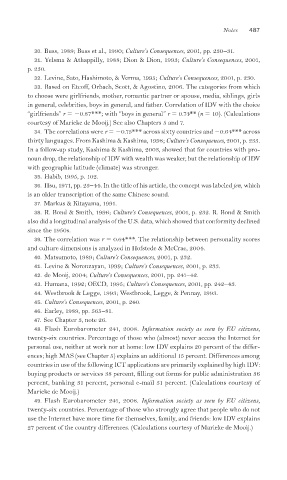Page 522 - Cultures and Organizations
P. 522
Notes 487
30. Buss, 1989; Buss et al., 1990; Culture’s Consequences, 2001, pp. 230–31.
31. Yelsma & Athappilly, 1988; Dion & Dion, 1993; Culture’s Consequences, 2001,
p. 230.
32. Levine, Sato, Hashimoto, & Verma, 1995; Culture’s Consequences, 2001, p. 230.
33. Based on Etcoff, Orbach, Scott, & Agostino, 2006. The categories from which
to choose were girlfriends, mother, romantic partner or spouse, media, siblings, girls
in general, celebrities, boys in general, and father. Correlation of IDV with the choice
“girlfriends” r 0.87***; with “boys in general” r 0.74** (n 10). (Calculations
courtesy of Marieke de Mooij.) See also Chapters 5 and 7.
34. The correlations were r 0.75*** across sixty countries and 0.64*** across
thirty languages. From Kashima & Kashima, 1998; Culture’s Consequences, 2001, p. 233.
In a follow-up study, Kashima & Kashima, 2003, showed that for countries with pro-
noun drop, the relationship of IDV with wealth was weaker, but the relationship of IDV
with geographic latitude (climate) was stronger.
35. Habib, 1995, p. 102.
36. Hsu, 1971, pp. 23–44. In the title of his article, the concept was labeled jen, which
is an older transcription of the same Chinese sound.
37. Markus & Kitayama, 1991.
38. R. Bond & Smith, 1996; Culture’s Consequences, 2001, p. 232. R. Bond & Smith
also did a longitudinal analysis of the U.S. data, which showed that conformity declined
since the 1950s.
39. The correlation was r 0.64***. The relationship between personality scores
and culture dimensions is analyzed in Hofstede & McCrae, 2004.
40. Matsumoto, 1989; Culture’s Consequences, 2001, p. 232.
41. Levine & Norenzayan, 1999; Culture’s Consequences, 2001, p. 233.
42. de Mooij, 2004; Culture’s Consequences, 2001, pp. 241–42.
43. Humana, 1992; OECD, 1995; Culture’s Consequences, 2001, pp. 242–43.
44. Westbrook & Legge, 1993; Westbrook, Legge, & Pennay, 1993.
45. Culture’s Consequences, 2001, p. 240.
46. Earley, 1989, pp. 565–81.
47. See Chapter 3, note 26.
48. Flash Eurobarometer 241, 2008. Information society as seen by EU citizens,
twenty-six countries. Percentage of those who (almost) never access the Internet for
personal use, neither at work nor at home: low IDV explains 20 percent of the differ-
ences; high MAS (see Chapter 5) explains an additional 15 percent. Differences among
countries in use of the following ICT applications are primarily explained by high IDV:
buying products or services 38 percent, filling out forms for public administration 36
percent, banking 31 percent, personal e-mail 31 percent. (Calculations courtesy of
Marieke de Mooij.)
49. Flash Eurobarometer 241, 2008. Information society as seen by EU citizens,
twenty-six countries. Percentage of those who strongly agree that people who do not
use the Internet have more time for themselves, family, and friends: low IDV explains
27 percent of the country differences. (Calculations courtesy of Marieke de Mooij.)

